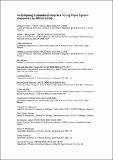An eclipsing substellar binary in a young triple system discovered by SPECULOOS
Author(s)
Triaud, Amaury HMJ; Burgasser, Adam J; Burdanov, Artem; Kunovac Hodžić, Vedad; Alonso, Roi; Bardalez Gagliuffi, Daniella; Delrez, Laetitia; Demory, Brice-Olivier; Ducrot, Elsa; Hessman, Frederic V; Husser, Tim-Oliver; Jehin, Emmanuël; Pedersen, Peter P; Queloz, Didier; McCormac, James; Murray, Catriona; Sebastian, Daniel; Thompson, Samantha; Van Grootel, Valérie; Gillon, Michaël; De Wit, Julien; ... Show more Show less
DownloadAccepted version (9.588Mb)
Open Access Policy
Open Access Policy
Creative Commons Attribution-Noncommercial-Share Alike
Terms of use
Metadata
Show full item recordAbstract
© 2020, The Author(s), under exclusive licence to Springer Nature Limited. Mass, radius and age are three of the most fundamental parameters for celestial objects, enabling insight into the evolution and internal physics of stars, brown dwarfs and planets. Brown dwarfs are hydrogen-rich objects that are unable to sustain core fusion reactions but are supported against collapse by electron degeneracy pressure1. As they age, brown dwarfs cool, reducing their radius and luminosity. Young exoplanets follow a similar behaviour. Brown dwarf evolutionary models are relied upon to infer the masses, radii and ages of young brown dwarfs2,3. Similar models are also used to infer the mass and radius of directly imaged exoplanets4. Unfortunately, only sparse empirical mass, radius and age measurements are currently available, and so the models remain mostly unvalidated. Double-line eclipsing binaries provide the most direct route towards the absolute determination of the masses and radii of stars5–7. Here we report the discovery by SPECULOOS (Search for habitable Planets EClipsing ULtra-cOOl Stars) of the 2M1510A triple system, consisting of a nearby, eclipsing, double-line brown dwarf binary and a widely separated tertiary brown dwarf companion. We find that the system is a member of Argus, a 45 ± 5 million-year-old moving group8,9. The system’s age matches those of currently known directly imaged exoplanets so 2M1510A provides an opportunity to benchmark evolutionary models of brown dwarfs and young planets. We find that widely used evolutionary models3 do reproduce the mass, radius and age of the binary components remarkably well, but overestimate their luminosity by up to 0.65 magnitudes, which could result in underestimations of 20% to 35% of photometric masses for directly imaged exoplanets and young-field brown dwarfs.
Date issued
2020Department
Massachusetts Institute of Technology. Department of Earth, Atmospheric, and Planetary SciencesJournal
Nature Astronomy
Publisher
Springer Science and Business Media LLC